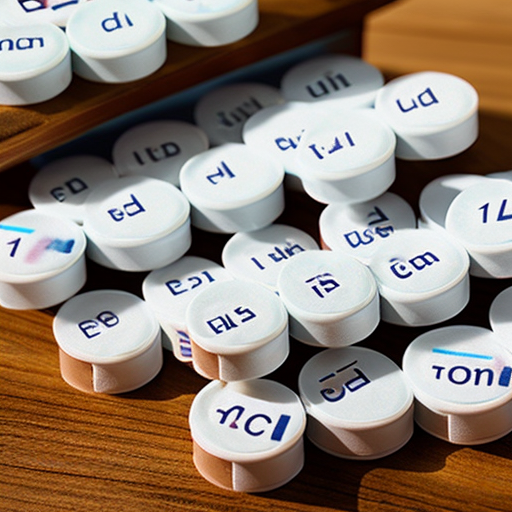Uncategorized
What is the duration of Clonazepam’s effectiveness? – ChatGPT No RX Pharmacy
Clonazepam: An Anticonvulsant and Antiepileptic Drug
Clonazepam is a medication prescribed to prevent and control seizures in patients. It is classified as an anticonvulsant and an antiepileptic drug. In some cases, it is also prescribed to treat panic attacks. Clonazepam, also known as Klonopin, belongs to the class of benzodiazepines that work to enhance the effect of a naturally occurring chemical in the brain, decreasing overactivity in the brain. Clonazepam can be taken independently or in combination with other medications. It is recommended that patients inform their doctor about their medical history and current medications to ensure the right dosage is prescribed.
Mechanism of Action of Clonazepam
Clonazepam is a benzodiazepine that increases the effects of the neurotransmitter GABA or Gamma-aminobutyric Acid. GABA functions as an inhibitory neurotransmitter that blocks or inhibits the initiation, sending, or receiving of chemical signals from one nerve cell to another. When the brain is overactive, repercussions like stress, anxiety, and epilepsy can occur. GABA works to decrease abnormal activity in the brain where low levels of GABA can have effects like stress or worrying and epilepsy or seizures. Clonazepam works to increase levels of GABA and produce a relaxing and calming effect in the brain.
Possible Side Effects of Clonazepam
The common side effects of Clonazepam include drowsiness, dizziness, loss of coordination, tiredness, and increased saliva production. These side effects should decrease with time as the body adjusts to the dose. Patients are advised to inform their doctor if they persist or worsen. The severe side effects of Clonazepam include frequent changes in mood or behavior, confusion or memory problems, signs of depression, suicidal thoughts or attempts, and thoughts about harming oneself. These severe side effects are unlikely but require immediate medical assistance if noticed.
Pharmacokinetics of Clonazepam
The half-life of a drug is the time it takes half of the active substance to leave the body. The half-life of Clonazepam is averaged between 30 to 40 hours. It takes five to six half-lives for a drug to completely leave the body, which means that Clonazepam can stay in the body for 6 to 9 days after the last dose. Clonazepam starts to work within one hour and can last for 8 to 12 hours. However, certain tests can still detect Clonazepam in the body. After the last dose, Clonazepam can be detected in the urine for 4 to 6 days, in a blood test for 5 to 6 days, in the saliva for 5 to 6 days, and in the hair follicle for a considerably longer time of three months as hair takes a long time to grow. Factors that may influence the duration of Clonazepam staying in the system include age, metabolism, weight, liver and kidney function, dosage, frequency and duration of use, and other drugs being taken.
Precautions to be Taken While Using Clonazepam
Patients who have been using Clonazepam for a long time may develop dependence or tolerance. It is suggested that patients inform their doctor if they think the prescribed dosage is not working instead of increasing it on their own to avoid addiction. Patients are advised to inform their doctor about their medical history, especially liver or kidney disease, breathing problems, bipolar disorder or pain, allergies to benzodiazepines, and glaucoma. Clonazepam is likely addictive and habit-forming, especially if patients have formerly misused or abused a substance. Patients are advised to use their dosage in moderation to avoid addiction and overdose. Clonazepam can make patients dizzy and drowsy. It is suggested that patients abstain from alcohol, cannabis products, and other CNS depressants as they can aggravate side effects.
Administration of Clonazepam
Clonazepam is orally administered to patients with seizures or epilepsy and panic disorders. Patients can take Clonazepam with or without food as directed by their doctor. The adult dosage for seizures is 1.5mg taken orally divided into three doses, which can be increased until the seizures are adequately controlled. The maximum dosage is 20mg a day. The dosage of Clonazepam prescribed will be based on the patient’s medical condition and response to treatment. It is suggested that patients take Clonazepam regularly, preferably at the same time each day, to get the maximum benefit from the treatment.

Clonazepam is a medication prescribed to prevent and control seizures in patients. It is classified as an anticonvulsant and an antiepileptic drug. In some cases, it is also prescribed to treat panic attacks. Clonazepam is the generic name for Klonopin, a class of benzodiazepines that work to enhance the effect of a naturally occurring chemical in the brain, decreasing overactivity in the brain. Clonazepam can be had independently or in combination with other medications. It is recommended that you inform your doctor about your medical history and the medicines you currently have so they can prescribe the right dosage for you.
How does Clonazepam function?
Clonazepam is a benzodiazepine that increases the effects of the neurotransmitter GABA or Gamma-aminobutyric Acid. GABA is known to function as an inhibitory neurotransmitter that blocks or inhibits the initiation, sending, or receiving of chemical signals from one nerve cell to the other. When the brain is overactive, repercussions like stress, anxiety, and epilepsy can occur. GABA works to decrease the abnormal activity in the brain where low levels of GABA can have effects like stress or worrying and epilepsy or seizures. Clonazepam works to increase levels of GABA and produce a relaxing and calming effect in the brain.
What are the possible side effects of Clonazepam?
The common side effects include-
1- Drowsiness
2- Dizziness
3- Loss of coordination
4- Tiredness
5- Increased saliva production
The common side effects of Clonazepam should decrease with time as your body adjusts to the dose. It is suggested that you inform your doctor if they persist or get worse.
The severe side effects of Clonazepam include-
1- Frequent changes in mood or behavior
2- Confusion or memory problems
3- Signs of depression
4- Suicidal thoughts or attempts and thoughts about harming yourself
The severe side effects are unlikely. However, it is advised that you immediately look for medical assistance if you notice them.
How long does Clonazepam take to work, and what is its half-life?
A drug or a substance’s half-life is described as the time it takes half of the active substance to leave your body. The half-life of a drug ideally remains unchanged irrespective of the dose and duration of treatment. The half-life of Clonazepam is averaged between 30 to 40hours. Usually, it takes a drug five to six half-lives for a drug to completely leave the body, which means that Clonazepam can stay in your body for 6 to 9 days after your last dose.
Clonazepam starts to work within one hour and can last for 8 to 12 hours. However, certain tests can still detect Clonazepam in your body. After the last dose, Clonazepam can be detected in the urine for 4 to 6 days, in a blood test for 5 to 6 days, in the saliva for 5 to 6 days, and in the hair follicle for a considerably longer time of three months as hair takes a long time to grow.
Factors that may influence the duration of Clonazepam staying in your system –
- Age, metabolism, and weight
- Liver and kidney function
- Dosage
- Frequency and duration of use
- Other drugs you may be taking
Precautions to be taken while using Clonazepam
- If you have been using Clonazepam for a long time, you may develop a dependence or tolerance. It is suggested that you inform your doctor if you think the dosage prescribed to you isn’t working instead of increasing it on your own to avoid addiction.
- It is suggested that you inform your doctor about your medical history, especially about liver or kidney disease, breathing problems, bipolar disorder or pain, allergies to benzodiazepines, and glaucoma.
- Clonazepam is likely addictive and habit-forming, especially if you have formerly misused or abused a substance. You are advised to use your dosage moderation to avoid addiction and overdose.
- Clonazepam can make you dizzy and drowsy. It is suggested that you abstain from alcohol, cannabis products, and other CNS depressants, as they can aggravate your side effects.
How should you have Clonazepam?
Clonazepam is orally administered to patients with seizures or epilepsy, and panic disorders. You can have Clonazepam with or without food as directed by your doctor. The adult dosage for seizures is 1.5mg taken orally divided into three doses which can be increased until the seizures are adequately controlled. The maximum dosage is 20mg a day. The dosage of Clonazepam prescribed to you will be based on your medical condition and response to treatment. It is suggested that you take Clonazepam regularly, preferably at the same time each day, to get the maximum benefit from the treatment.

 Skip to content
Skip to content


